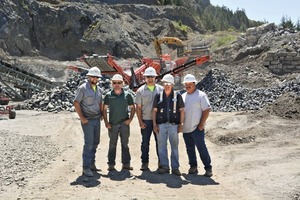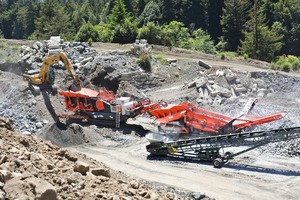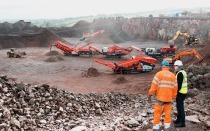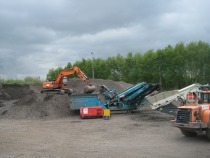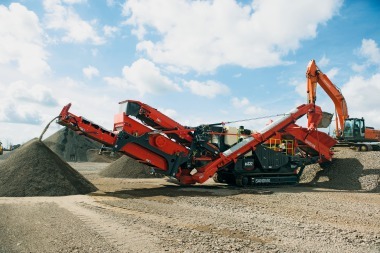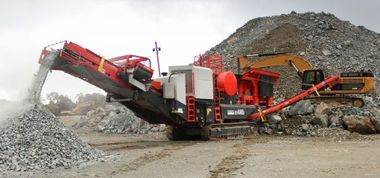A heavy-duty mobile solution in a quarry
The Northern California company, Canyon Rock, is a full service operation, featuring a complete line of aggregate and recycled material, as well as an auxiliary division offering ready mix and concrete products. In 2014 Canyon Rock acquired its second quarry. The reason for this acquisition was to provide material for rip rap, and stone, for the Sonoma-Marin Area Rail Transit project; a 70 mile long rail and bikeway which crosses the region. It was essential that the company chose the right primary crusher; one that could handle heavy duty quarrying applications easily and for many years to come. The solution was provided in the form of a Sandvik Construction UJ440i tracked jaw crusher supplied by Sandvik’s distributor Interval Equipment (Fig. 1).
“The UJ440i is a step-up,” said Canyon Rock co-owner, Jonathan Trappe when emphasizing the machine’s strengths. “The chassis, the frame, the belt – everything is sturdier. We were looking for something that would run well and last for 15-20 years”. The fact that the UJ440i crusher is able to efficiently turn out two finished products from the quarried rock was the real deal clincher for Canyon Rock.
The UJ440i possesses a jaw size of 1200 mm x 800 mm, and has proved capable of reducing large volumes of rock at high rates of production – up to 700 metric t/h. Push buttons also operate the hydraulic close side setting, which can squeeze the opening down to 100 mm from 275 mm. Additionally its conveyor belts are 1350 mm wide and sit on hydraulic drive units that can be reversed as needed.
Cost efficient power plant
Power is provided by a 425-horsepower Volvo diesel engine that directly drives the crushing processes. The engine is able to operate without critical loss of power whilst consuming a meagre eight gallons of fuel per hour. Practical deployment and use of the UJ440i is enhanced through the fitment of a 300 gallon fuel tank, which enables the crusher to process rock all day without interruption for fueling. Yet should the need for interrupting the operation be required, emergency stop buttons are located at several appropriate places on the frame of the machine.
The only way was mobile
The acquisition of the Cazadero quarry however created the need for a new approach to material production, entailing the use of equipment that could produce rip rap and allow Canyon Rock entry into the market for the sub-base and erosion control material.
Despite the excellence of the Allis-Chalmers, Svedala and latterly, Sandvik Construction static crushing and screening equipment, when it came to purchasing their new crusher Canyon Rock knew they required a mobile unit. This was essential as not only is the mobile jaw crusher able to follow the contour of the quarry face under its own power as the quarry is blasted away, but also essential when there are drops and increases in the operating areas of the quarry. All of these elements are easily accomplished due to the QJ440i travelling on its 500 mm wide, 4200 mm long crawler tracks, which enables the machine to navigate a 20 degree slope.
Scalping screen unit aids productivity
The company has now acquired a Sandvik QE440 mobile scalping screen unit to enhance the two-product output at Cazadero. The QE440 boasts the largest total scalping area in its class, and features three broad hydraulic material conveyors with high discharge heights for major stockpiling. It is able to produce up to 900 metric t/h (Fig. 2). “We are really happy with the QE440,” says Jonathan Trappe. He acknowledged that the family wasn’t sure if the machine would be able to handle larger rocks conveyed to it by the crusher, but added – “It handles the tonnage the UJ440i gives it with no problem.”

